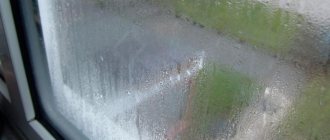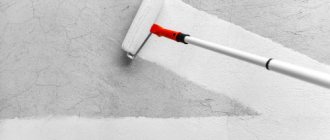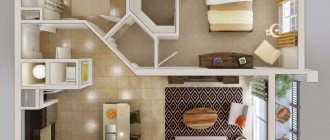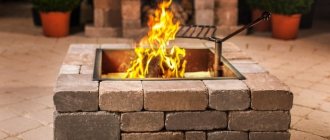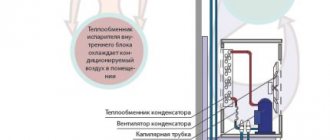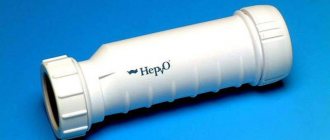The split system consists of internal and external parts. The process of operation of the device in cooling mode is accompanied by the release of liquid. Is condensation from the outdoor unit of the air conditioner not the most pleasant substance in this design? And bringing it into the premises is generally extremely undesirable, right?
There are no special technical difficulties in installing a drainage line to remove moisture. A special tube for collecting condensate is usually installed together with the outdoor unit of the split system. We will tell you about all the popular options for further arrangement of the drain.
Useful recommendations may be useful to you when monitoring contractors. Perhaps you will use our tips for making your own system for draining and recycling condensate.
Where does unnecessary liquid come from?
The air in the air conditioner is cooled by circulating refrigerant. The element of the flow pattern in which the temperature decreases is called the evaporator.
The device received this name because droplets of moisture, that is, “perspiration,” appear on its body during operation. The resulting liquid is the same condensate that requires removal from the split system unit.
Moisture is released from warm air at the moment of sudden cooling. One operating unit can accumulate up to 15-20 liters of liquid per day
Draining accumulated moisture is important for proper operation of the air conditioner. The climate control unit operates from the electrical network. As you know, water is a good electrical conductor. At high humidity there is a risk of a short circuit in the device circuit. Breakdown of expensive electrical equipment can be prevented by proper condensate drainage.
How to clean the air conditioner drain
Often the owner himself tries to clean the drain pipe of the air conditioner at home using improvised means, for example, wire. This method allows you to solve the problem, but only for a few days. Soon, debris from the heat exchanger will re-enter the drainage system and clog the drain hose, causing the air conditioner to leak. Therefore, it would be correct to clean not only the drainage system, but also to sanitize the filters located in the indoor unit.
Before you clean the air conditioner drain yourself, you should study the operating instructions for the installed wall-mounted unit, but in most cases the device must be partially disassembled. It’s better to watch the video on how to properly dismantle it.
The system is cleaned in the following sequence:
Preliminary preparation. Before cleaning the drainage of the air conditioner, you should disconnect the device from the electrical network. Then you need to remove the cover that blocks access to the indoor unit of the air conditioner.
Cleaning filters. After removing the cover, the coarse filters can be removed. They should be washed under running water, using, if necessary, a soap solution to remove old dirt. Washed filters must be dried thoroughly.
Cleaning the tray. The next step is to remove the pan in which the condensate accumulates, while simultaneously disconnecting the drain hose. In order for the operation to proceed correctly, it is recommended to clarify the disconnection method in the operating instructions
The pan is thoroughly washed with soapy water; it is especially important to thoroughly clean the drain hole
Cleaning the drain pipe. To clean the drain pipe, use a vacuum cleaner. With regular cleaning, it does an excellent job of removing dirt, but if the system was last serviced a long time ago, you will have to pour a special liquid for cleaning air conditioners inside the tube, which will soften the blockage. The liquid is poured into the tube using a syringe and waited for about 30 minutes, after which the vacuum cleaner is used again to remove the softened dirt.
Disinfection of the system. After completing all system cleaning procedures, care should be taken to disinfect the device. To treat the tray, filters and tube, you can use chlorhexidine at home, which can be purchased at any pharmacy (a review of the products is given in this article, and the general procedure for cleaning split systems can be found here).
The tray is wiped with a cloth soaked in the solution, the filters are treated with a spray bottle, and chlorhexidine is simply poured into the drain tube for 15 minutes, after which it is washed with running water.
The final stage. After processing the main systems, use a soft clothes brush to remove dust and dirt from the heat exchanger and replace the cover.
Regular air conditioning maintenance will help maintain a favorable and safe climate in the apartment.
How does drainage occur in practice?
A small sociological survey conducted among air conditioner users showed interesting statistics.
To the question where do you drain the condensate, the following answers were received:
- Just going outside – 68%;
- To the sewer by gravity - 16%;
- To a special drainage system – 8%;
- What kind of condensate is this? - 8%.
Let us explain the essence of liquid discharge for the unenlightened last category of owners of split systems. For those who do not know where the condensate formed in the air conditioner goes, it is useful to read the instructions for the device. It gives clear instructions for installing the drain outlet from the air conditioner unit.
The problem requires special attention in large private houses with several air conditioners in different rooms. An organized solution for condensate collection should be made at the design stage of the climate system
You should remember the peculiarities of climate control equipment that produces liquid not only during design and installation. It is also necessary to monitor the process of moisture removal when operating the air conditioner.
Self-production
Due to the considerable, in modern times, cost, from 1.5 to 2 thousand rubles. Many air conditioner owners are wondering: how to make a siphon for an air conditioner with your own hands?
Our company’s specialists answer such questions unequivocally: Making a device with a check valve is quite difficult without special equipment.
At home, you can make an ordinary U-shaped structure from a plumbing pipe, but after some time of inactivity of your climate control equipment, the water from the water seal elbow will evaporate and your apartment will be filled with the “wonderful aromas” of the sewer. In addition, a drainage unit that can be made from improvised means will be quite bulky and difficulties will certainly arise during its installation.
What is condensate?
The risk of harm to health from improper removal of evaporated moisture is much more dangerous than the threat of a split system breakdown. Although, in terms of its chemical composition, condensate is just ordinary water. But the fact is that pathogenic microbes accumulate in stagnant warm moisture.
The consequences of not draining condensate can be:
- unpleasant musty smell from the air conditioner;
- reproduction of Legionella pathogens;
- formation of various forms of mold.
It is a mistake to consider air conditioning to be the main cause of severe Legionnaires' disease. A dangerous microorganism lives in the soil, swimming pools, and decorative fountains. Wherever there is stagnant water, even in medical physiotherapy equipment, there is a risk of encountering Legionella.
Removing excess moisture from the split system is necessary for the health of your family. Constantly draining condensate will not give a chance for water stagnation to develop
The drainage system is designed to drain excess moisture. Correctly performed condensate drainage and timely maintenance make air conditioning equipment completely safe.
Installation of the outdoor unit
The choice of location for installing an outdoor unit must be taken extremely seriously - not only the efficiency of the device and its safety, but also the comfort of both the owners and residents of neighboring apartments will depend on the result.
The outdoor unit is attached to the wall of the building or on the side of the balcony. It is allowed to install the block inside the balcony, but only if it is not glazed. The unit must not be installed on the ground unless the equipment is properly supported.
The surface on which the outdoor unit will be mounted must be rigid, durable and able to withstand the weight of the equipment (and the unit can weigh several tens of kilograms). The outdoor unit is mounted on brackets, which are sometimes supplemented with vibration-damping gaskets, although this is not a mandatory step.
It is important that the outdoor unit is level and positioned strictly horizontally, as distortions can lead to malfunctions. The block body is installed so that there is a gap of empty space between it and the wall
There should be no wall protrusions or other obstacles near the unit that interfere with air exchange. Poor air circulation reduces the performance of the air conditioner.
The unit should not be located in close proximity to the windows of neighboring apartments - the noise it produces and warm air currents can disturb residents, and this will become a reason for complaints from the housing inspectorate. If you plan to remove the drainage channel through the outdoor unit, then you need to mount it so that condensation does not drip onto the walls, window sills and passers-by below.
The simplest and most economical type of installation is to install the outdoor unit under the window. However, it is not always successful. Thus, due to the close location of the outdoor unit to the window, noise and vibrations arising from the operation of the device can be felt indoors. Therefore, many owners choose to install the outdoor unit on blank walls, away from windows. In this case, the wall itself will become a reliable protection against noise. But installing the block on it will also cost more, since it will have to be hung, at best, using a stepladder (if we are talking about the lower floors of the house), and at worst, by resorting to the services of industrial climbers.
Unlike most types of household appliances, an air conditioner requires servicing. Not only the indoor unit, but also the outdoor unit is subject to periodic inspection and cleaning. Therefore, the easy availability of the block for craftsmen is a definite plus. But it’s not always possible to figure it out in such a way that it’s convenient to get to the block, and at the same time it doesn’t interfere with anyone. It is usually easier to inspect outdoor units mounted under a window (some manufacturers develop units with an easily removable top cover for this purpose), on the ground floor, on a balcony. If the block hangs at a distance from the windows or even on a blank wall, then the services of the same industrial climbers will be needed for inspection.
Outdoor units are designed taking into account the fact that they can be placed outdoors, but it is better to protect them from exposure to direct sunlight and precipitation. For these purposes, you can install a canopy on top of the outdoor unit - it will protect the equipment from the sun, water, snow, as well as from falling icicles and ice when cleaning the roof.
Link on topic: Climate control equipment (humidifiers, split systems, air conditioners) in questions and answers
What methods are there for discharging water?
The cheapest option is to remove the by-product by gravity. But even in this fundamental implementation there are variations. They are located at the point where condensate is received.
The main methods of draining liquid:
- Just take the drainage pipe outside and leave it on the wall with condensation dripping. This standard technique is used in most installed split systems.
- Connect a long drainage hose to the outlet and collect the condensate in a container. In hot weather, you will have to monitor the filling of this drain tank, which is not entirely convenient.
- Drain pipes can be routed into a nearby sewer pipe or sink. Such a gravity system requires strict adherence to the slope of the highway during installation.
- Install a circuit for forced removal of moisture into the sewer using a pump. A pump is used at a considerable distance from the air conditioner to the point where condensate is released.
Air conditioning is not the cheapest of modern technological advances. Therefore, you should not skimp on the correct design and installation of a waste moisture drainage system.
Collecting condensate in a plastic bottle does not require material costs. The main thing is to drain the accumulated liquid into the sewer in a timely manner.
In any case, drainage must be done correctly from the very beginning of installation of the split system. Whatever option you choose for removing condensed moisture.
How to clean the indoor unit of an air conditioner: detailed instructions (+ disassembly video)
Instructions for completely cleaning the indoor unit:
- The device is disconnected from the network.
- The front panel (cover) is removed. To open it, you need to pry the panel and pull it towards you and up. This is how almost all household air conditioners open.
- Get a filter.
Let’s make a digression and list the types of filters and the features of their cleaning:
- The coarse filter is a fine-mesh polymer mesh that traps dust, fluff, and animal hair. Located immediately behind the front panel. If used frequently, it can be cleaned every 2-3 months. You can wash the mesh under running tap water, but you cannot wipe it - the filter must dry naturally.
- Charcoal - removes unpleasant odors. It can't be cleaned, you just have to change it.
- Zeolite - absorbs chemical compounds from the air, neutralizes unpleasant odors. Can be washed under the tap.
- Electrostatic - cleans from small dust particles (more effectively than a coarse filter). Can be washed under the tap.
- Plasma - also cleans the air from small dust particles (the cleaning principle differs from electrostatic). Cleans with a brush.
- Photocatalytic - retains all types of contaminants, including mold spores and unpleasant odors. Can be washed under the tap.
After removing the filter, we continue cleaning the indoor unit:
- We take out the condensate tray and clean the drainage (read how exactly below).
- Remove the main part of the body. In some models it is held in place by latches, in others by self-tapping screws. Self-tapping screws can be covered with decorative plugs. The case also gets dirty, so after removing it we also clean it (you can simply wipe it with alcohol-based wet wipes).
- Medical shoe covers are put on the electronics unit to protect it from moisture.
- The wall under and next to the air conditioner is sealed with polyethylene (or a service package is attached to the wall). The wall must be sealed along its entire height (from the air conditioner to the floor). The floor is also covered with polyethylene and covered with rags (since when washing, dirty foam and water will drain from the block).
- If dust is visible under the body, you can immediately remove it with a vacuum cleaner or shake it out with a long-bristled brush.
- All surfaces that were hidden under the block are washed with a disinfectant (purchased or prepared). The most careful thing to do is wash the fan blades and radiator (especially between the plates). If you use a store-bought disinfectant liquid, the foam may not be washed off immediately after application. Wait 15-25 minutes for the foam solution to loosen the dirt.
- The foam is washed off. You can use a regular spray bottle with clean water. First, the radiator is cleaned of chemicals, then the fan blades. If you have a steam generator, you can use steam instead of water.
- All parts dry naturally.
- The indoor unit is assembled in the reverse order: the housing is installed, filters are installed, and the front panel is attached.
- The device is connected to the network and turned on for testing.
Requirements for installation of drainage pipes
Air conditioner manufacturers do not recommend using electrical wiring corrugations or garden hoses in condensate drain lines. The route of the gravity condensate drainage system should not have bends or sharp turns.
Special smooth and corrugated pipes for condensate drainage have the required strength. They are made of polyethylene, polystyrene, and metal-plastic.
The drainage line parameters are as follows:
- Horizontal sections have a slope of about 3%, on turns the maximum permissible angle is up to 45o;
- The standard inner diameter of pipes is usually 16 mm, hoses cannot be inserted into each other;
- Tight connection of the hose to the split system unit is ensured by fitting adapters.
At the bottom of the housing of the external unit of the air conditioner there is a special hole for connecting a flexible drain pipe.
Errors when installing the drainage line are costly for the owner of the air conditioner. Improperly equipped drainage from a split system can cause flooding of the basement and lower floors of the house
To lay connecting cables and a condensate drain hose between the outdoor and indoor units of the split system, a hole is punched in the wall. It must be made with a slope towards the street. Even with a scheme with forced removal of liquid. After all, the pump may fail and for some time the moisture will be removed by gravity.
Features of operation
When operating, the air conditioner drain pump does not make much noise. Her work is neither heard nor seen by humans. The only manifestation may be a small stream of water on the outer contour of the device. At the same time, the noise level from the pump is easily drowned out by the operation of the entire air conditioning system.
In peristaltic systems, work is characterized by special silence. They don't make any sound. Rather, you can hear the sound of flowing water.
Drain pumps for air conditioners, like any equipment of this type, are characterized by a long service life. In this regard, if the manufacturer has a good reputation in the market, which he values, he will only have to buy a drainage pump for the air conditioner once.
Discharge into the sewer system
The optimal solution is to drain the condensate into the sewer. The problem with this type of drainage is that air-conditioned residences usually do not have a drainage section.
The following article, which we recommend reading, will tell you what to do if condensation from the air conditioning unit flows into the room being treated.
The solution is one of the following options:
- Laying a drainage pipe observing slopes to a sewerage system in another room.
- Installation of a sewer pipe to the room in which the air conditioning unit is installed.
Choose a condensate drainage method that is acceptable to you. As a rule, labor intensity and cost of materials are lower in the first case.
Diagram of the drainage line inside the house
The outdoor unit does not produce condensate in cooling mode. Water dripping on the heads of passers-by in the hot summer from the air conditioner is collected in the indoor module. And then it is removed from a special storage bath through a drainage pipe to the outside.
But it is not at all necessary to remove the liquid to the external module of the system. The condensate collected in the room can be directed from the air conditioner into the sewer system to the nearest riser indicated in the piping diagram inside the house. The shorter the length of the drainage system section between the internal module of the split system and the sewer, the easier it will be to maintain and repair the main line.
During design and installation, a large number of turns of the condensate drain line should be avoided. It is better to make a hole in the wall when laying a line into an adjacent room
Connecting the condensate drain line to the sewer system requires knowledge and experience. If you are going to do such work yourself, consult with craftsmen who have practical experience in this field.
Installing a condensate siphon
A water seal serves as protection against the penetration of unpleasant odors from the sewer into the room. This function is performed by a conventional sewer siphon. The device is mounted at the junction of sewer and drainage pipes.
Moisture from the air conditioner first accumulates in the siphon. At a certain level of the device there is a shutter that releases liquid into the sewer. Siphons are equipped with a protective valve that protects against the penetration of odors.
According to installation methods, siphons are classified into:
- closed built into the wall;
- external open design;
Structurally, they are conventional with a water seal, ball with a rubber locking element, dry with a jet break and without this function, etc.
Built-in closed siphons have different depth dimensions. To install them in the wall, you should select a model that corresponds to specific dimensions.
External siphons made of transparent plastic are convenient, allowing you to monitor their overflow and contamination
The efficiency of a device is characterized by its throughput. Different models of siphons differ in the type of thread. Please consider this point when purchasing equipment.
Types of devices
All devices of this type can be divided into several varieties. But all of them will be united by the word “drainage”, since any of them are like that.
There are 4 main groups of the most common types of pumps:
Storage (separate) pumps. They have a special storage tank for liquid. There is a sensor inside that reacts to the water level and turns the device on/off. Their design allows installation on a hose, drainage pipe and inside the pan itself. The place where the pump can be installed has a separate block, which is connected to the storage tank by a flexible tube (maximum length up to 2 meters). The efficiency of such devices is quite high. The unit can pump out up to 50-55 liters per hour, and this will be enough for almost all air conditioners that are on the market today. Storage pumps can lift water to a height of 14 meters. If a higher value is needed, then more powerful pumps are installed.
- 2. Liquid. Compared with the previous type, liquid tanks are characterized by higher productivity and power. They can pump up to 1,500 liters per hour, but at the same time they raise water to a height of up to 6 meters, which is half as much as separation devices. But this is not critical, since the filling units function as external units and split systems. They pump water directly into the sewer, so lifting to a great height is not necessary. Also, the installation of sensors and floats is not provided, since the storage tanks are small.
- 3. Built-in pumps. Such devices are an integral attribute of various split systems, duct and cassette air conditioners. Their productivity does not exceed 170 liters of pumped out liquid per hour of operation, so they are able to fully ensure the normal functioning of the device. But there are times when this type of drainage pump will require the installation of an additional pump. This is mainly necessary when installing in extreme conditions.
- 4. Peristaltic. Such a drainage pump for an air conditioner is installed if it is necessary to raise the liquid more than 15 meters in height. But this dramatically affects productivity, since it can pump out up to 10 liters per hour of operation. There are exceptions when the power in peristaltic pumps is several times greater than in conventional models, however, the price of such devices will be higher.
Why do you need to drain into the sewer?
Connecting the drainage system with the sewer system is the most expensive option for removing condensate from a split system. But experts recommend choosing this method, despite the costs. Because he is the most correct in all respects.
The feasibility of a complex option
The first air conditioners were installed without much thought for the environment. But today environmental issues come to the fore in the technical development of society.
Expensive climate control equipment is purchased for a long service life. Your caring care will prolong his life
The health of humans and their smaller pet friends requires care. Illnesses take away energy and money for medicine. Therefore, the most expensive method of diverting the drainage line into the sewer will pay off over time due to savings on treatment.
Clean air without harmful vapors from dripping condensation is useful both in a country house and in local areas in multi-storey urban areas.
What do the rules dictate?
Discharging liquid into the sewer is only recommended, but is not prohibited by the instructions for climate control equipment. It’s just that this method is the most gentle for proper long-term operation of the device. It eliminates the dangerous consequences of the accumulation of large amounts of moisture on the air conditioner evaporator.
Constantly slipping statements about the legal requirements to install a condensate drain only in the sewer system are unfounded. Those interested can verify this by reviewing the judicial practice on claims against owners of air conditioners with gravity street condensate drains. The courts refuse to satisfy such claims as they are not justified by legislative norms.
There are local bans on the release of condensate into the atmosphere as part of decisions made by housing developments. We will not discuss the legality of such documents. As they say, the collective farm is a voluntary matter.
Building codes require condensate to be discharged into the sewer system. But compliance with SNiPs is mandatory only for new premium-class residential buildings put into operation with an installed air conditioning system
And yet there is one general prohibition that applies to any condensate drainage systems. Do not drain moisture from the air conditioner into a storm drain. This is dangerous for the equipment. Due to increased pressure during rain, water may flood the air conditioner through the drain pipe.
Disadvantages of gravity drainage to the street
A simple accessible method is used for reasons of saving time on installation and money on paying for the services of craftsmen. However, this method of removing condensate has a number of unpleasant nuances.
Water flowing out of the drain pipe:
- pollutes the facade, windows, and sometimes gets on passers-by;
- disrupts the silence of the night, spreads dangerous germs;
- slowly but surely destroys the structural elements of the building.
The sight of dirty puddles under the module does not cause aesthetic delight. The sound of drops at night may not bother you at all. But it is unknown how your sensitive neighbors in an apartment building or townhouse will react to noise.
In a private house, a hose with dripping water hanging on the wall spoils the appearance with its sloppiness. Steam particles carry organic harmful components of condensate throughout the local area
The water itself, formed from collecting condensate, is an undesirable product and requires disposal. From the point of view of hygiene, ethics, and the safety of people and pets, it is best to dispose of such waste liquid into the sewer system.
Overview of siphon for collecting condensate from air conditioning systems
Description of the siphon
Built-in siphon for collecting condensate from air conditioning systems, vertical, with a 93mm high water seal and a mechanical odor-locking device that does not allow odor from the sewer when the water dries in the water seal, with a decorative cover. Inlet pipe Ø32mm for soldering PP pipes with an elastic adapter for connecting pipes Ø16, Ø20, Ø25mm. Outlet pipe Ø16, Ø20, Ø32mm.
Siphon equipment
- The lower part of the mounting box is 166*120*42mm (H*W*D) made of UPS.
- The upper part of the mounting box is 176*130*48mm (H*W*D) made of UPS, which has a decorative cover 176x130mm cut to the level of the plaster with spring clips for fastening to the lower mounting box.
- A collapsible siphon with a water seal and a mechanical odor-locking device - a ball, made of PP.
Technical characteristics of the siphon
- Connecting dimensions: Input Ø16, Ø20, Ø25, Ø32mm, Output Ø16, Ø20, Ø32mm.
- Weight: 0.35 kg.
- Throughput: 0.09 l/s.
- Service life: at least 50 years.
Causes of Drain Line Failure
The consequence of improper installation or the use of low-quality materials is condensate leakage from the drainage system. In such cases, you have to pay for additional work by specialists to eliminate defects.
The causes of the malfunction are the following:
- The hole in the wall for the drainage pipe and other connecting conductors between the outdoor and indoor units is drilled parallel to the floor, and not with a slope towards the street;
- Weak insulation or its complete absence on the freon tube causes moisture to collect on its surface and condensate to drain outside the drainage system;
- Kinks and damage to the laid drainage pipe block the path to the free or forced flow of moisture, causing overflow and leaks from the condensate drainage line.
Due to poor-quality rolling, a freon leak may occur. Then the heat exchanger freezes and moisture drains from it when the air conditioner is turned off.
The split system should not be used to heat a room when the outside temperature is below zero. With the exception of air conditioners equipped with heated drain pipe and compressor
In winter, when the air conditioner is turned on for heating, moisture from the hot air forms on the external module of the split system. The drainage tube freezes at low temperatures, and a leak appears on the entire surface of the outdoor unit.
The reasons listed are not exhaustive. Breakdowns of the drainage system and condensate leaks can also occur due to improper care and contamination of individual parts of the split system. Our recommended article will introduce you to the rules and specifics of cleaning climate control equipment.
Flaring of copper tubes
We move on to the stage of preparing the tubes.
Mistake No. 5 You can cut them only with a special pipe cutter, no hacksaws or grinders!
When making a cut, it is necessary to hold the end of the copper pipe strictly downward in order to prevent any chips from getting inside.
The ends are processed with a rimmer.
https://youtube.com/watch?v=lW7wjQICPOM%3F
Error No. 6 Flaring is done with a special tool with an eccentric. Don't forget to put the connecting nut on the tube before this step!
The width of the flare should be such that the connection eventually fits freely and unhindered into the nut.
The height of installation of the tube in the rolling clamp is strictly regulated.
The simplest and most proven old-fashioned way to determine the quality of rolling, at least at the initial stage, is to see your reflection in the “skirt”.
Flaring of the pipes of the outdoor unit will have to be done outdoors on weight. Otherwise, the line simply will not fit through the hole.
Error No. 7 Please note - if the installation does not take place on a hot, warm day, then when bringing copper pipes home from the street, close their ends and be sure to wait time for the copper to reach room temperature. If you bring them in cold and open, then due to the dew point effect, condensation will form inside the tube, which, on a poorly evacuated air conditioner, can lead to dire consequences
If you bring them in cold and open, then due to the dew point effect, condensation will form inside the tube, which, on a poorly evacuated air conditioner, can lead to dire consequences.
Conclusions and useful video on the topic
Correct installation of a siphon for the drainage system for discharging condensate into the sewer system:
How not to drain condensate into the sewer system, analysis of errors in installing an air conditioner drainage system:
If the system for draining moisture from your split system does not suit those around you, think about changing the way you remove unnecessary liquid. You can independently drain condensate into the sewer system from the air conditioner drainage system or have specialists install it.
Have you already completed this task and are ready to share your practice? Tell us about the important points missed in this review of the problem of condensate drainage? We look forward to publishing your photos, questions, comments, and useful tips.
1. General diagram and rules for installing an air conditioner consisting of a split system
In order for an air conditioner to fully live up to the expectations placed on it, three main conditions must be met:
— choose a model according to the volume of the room;
— install the air conditioner correctly;
— operate it in accordance with all rules, taking preventive measures in a timely manner.
Let's consider the rules for installing an air conditioner, namely, split-system type air conditioners will be considered. As practice shows, the cause of more than half of the cases of unsatisfactory operation of the air conditioning system or its premature failure is incorrect installation. Improper installation of an air conditioner can minimize the service life of even a very high-quality and expensive device.
